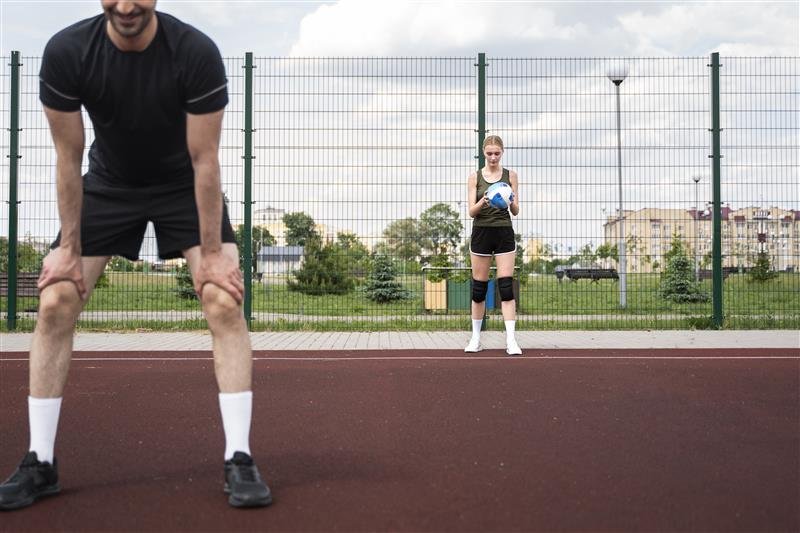When selecting indoor sports flooring, performance, safety, and durability are critical , but these qualities alone are not enough for professional or competition-grade facilities. The flooring must also comply with international certifications and standards to guarantee it meets official requirements.
The core concern for facility owners, sports organizations, and managers is:
“Is the flooring officially certified by relevant international sports bodies (eg, DIN, EN, FIBA, etc.) for use in professional or official competitions?”
In this blog, we explore why certifications matter, the key standards and their implications, how compliance is tested, and why certified sports flooring is a wise investment for both safety and performance.
Why Certifications and Standards Matter
1. Athlete Safety
Certified sports floors are tested to ensure:
- Shock absorption and force reduction meet minimum safety thresholds.
- Slip resistance prevents falls and injuries during rapid movements.
- Surface stability maintains consistent playing conditions across the facility.
Standards compliance ensures athletes perform at their best without unnecessary risk .
2. Fair Play and Official Use
- International competitions require floors that meet specific standards .
- Using uncertified flooring can disqualify facilities from hosting official events .
- Certified flooring guarantees uniform ball bounce, surface evenness, and traction as expected in competitive play.
3. Longevity and Performance
- Standards often assess durability, wear resistance, and dimensional stability .
- Certified flooring typically maintains performance metrics over time, even under heavy foot traffic.
- Investing in certified floors reduces maintenance costs and prevents premature replacement.
4. Liability Protection
- Facilities that install certified flooring demonstrate compliance with recognized safety standards .
- This can minimize liability risks in case of injuries or accidents.
Key Certifications and Standards
Sports flooring certifications vary depending on region, sport, and material type. Below are some of the most widely recognized certifications:
1. FIBA (Fédération Internationale de Basketball)
- Focus: Basketball flooring.
- Criteria: Ball bounce consistency, shock absorption, vertical deformation, and surface friction.
- Importance: FIBA-certified courts are required for international basketball competitions.
2. BWF (Badminton World Federation)
- Focus: Badminton court flooring.
- Criteria: Friction coefficient, vertical deformation, shock absorption, and surface evenness.
- Importance: Ensures fast, controlled gameplay while protecting athletes’ joints.
3. ITTF (International Table Tennis Federation)
-
- Focus: Table tennis floors.
- Criteria: Surface friction, ball bounce, and stability for precise play.
- Importance: Essential for professional tournaments and club facilities.
- Focus: Table tennis floors.
4. DIN (Deutsches Institut für Normung)
- Focus: European standardization.
- Criteria: Flooring mechanical properties, impact absorption, and durability.
- Importance: Ensures compliance with European sports facility safety regulations.
5. EN Standards (European Norms)
- Examples: EN 14904 – standard for multi-sport indoor flooring.
- Criteria: Shock absorption, vertical deformation, ball bounce, and slip resistance.
- Importance: Required for European sports halls and multi-purpose facilities.
6. ASTM (American Society for Testing and Materials)
- Focus: North American standards for flooring materials.
- Criteria: Mechanical properties, durability, fire resistance, and safety.
- Importance: Provides benchmarks for building codes and facility safety.
7. Floorscore Certification
- Focus: Indoor air quality.
- Criteria: Low VOC emissions from flooring materials.
- Importance: Ensures a healthy indoor environment, especially in schools and gyms.
8. Green Label Certification
- Focus: Sustainability.
- Criteria: Environmentally responsible materials and manufacturing processes.
- Importance: Demonstrates commitment to eco-friendly sports facilities.
Testing and Compliance Process
1. Laboratory Testing
-
- Shock absorption testing – determines force reduction.
- Vertical deformation – measures surface compression under load.
- Shock absorption testing – determines force reduction.
- Vertical deformation – measures surface compression under load.
- Ball bounce consistency – ensures proper rebound for the sport.
- Slip resistance – evaluates traction under dry and wet conditions.
- Durability tests – assesses wear resistance over time.
- Shock absorption testing – determines force reduction.
2. Field Testing
-
- Some standards require on-site verification.
- Ensures installation quality matches laboratory-tested material properties.
- Some standards require on-site verification.
3. Certification Issuance
- Manufacturers receive a certificate or label once the flooring meets all requirements.
- Certificates often include validity periods, after which re-testing may be necessary.
Benefits of Certified Flooring
1. Guaranteed Performance
- Certified flooring ensures athletic performance metrics like energy return, force reduction, and vertical deformation are met consistently.
2. Safety Assurance
- Proper shock absorption and slip resistance minimize the risk of injuries during jumps, sprints, and rapid direction changes.
3. International Competition Approval
- Hosting professional events requires certified floors.
- Athletes compete under recognized and fair playing conditions.
4. Facility Credibility
- Certified floors enhance reputation, attracting athletes, coaches, and events.
- Demonstrates a commitment to quality, safety, and professionalism.
5. Long-Term Cost Savings
- Certified floors are engineered for durability, reducing replacement frequency.
- Properly tested materials withstand heavy traffic and equipment use without compromising safety or performance.
Choosing Certified Flooring
1. Identify Sport Requirements
- Determine the primary sports: basketball, volleyball, badminton, table tennis, or multi-purpose.
- Check specific certification standards relevant to each sport (FIBA, BWF, ITTF).
2. Verify Manufacturer Credentials
- Ensure the manufacturer has tested and certified products.
- Ask for official certification documents.
3. Evaluate Subfloor Compatibility
- Certified flooring must be installed on a subfloor that meets manufacturer requirements.
- Proper installation ensures certification performance metrics are achieved.
4. Consider Multi-Purpose Use
- Multi-sport facilities may need EN 14904 or ASTM-compliant floors.
- These standards ensure safe and consistent performance for all activities.
5. Check Environmental Certifications
- For schools and public gyms, Floorscore and Green Label certifications ensure healthy indoor air quality and sustainable materials.
Common Misconceptions About Certification
Misconception 1: All Sports Floors Are Certified
- Not all floors on the market meet international standards.
- Only floors that have been tested and officially certified by recognized bodies carry valid certifications.
Misconception 2: Certification Is Only for Professional Facilities
- While essential for professional competitions, certified floors benefit all facilities by ensuring safety and optimal performance.
Misconception 3: Certification Guarantees Lifetime Performance
- Certifications ensure initial compliance, but proper installation, maintenance, and care are required to maintain performance over time.
Maintaining Certification Standards
1. Proper Cleaning and Maintenance
- Avoid abrasive cleaners that can damage surface friction or wear protective layers.
- Regular inspections help maintain seam integrity and flatness.
2. Routine Performance Testing
- Periodic testing for shock absorption, vertical deformation, and traction helps verify the floor maintains certification metrics.
3. Environmental Control
- Maintain stable temperature and humidity to prevent warping or expansion.
- Particularly important for wooden or modular floors.
Case Study: Certified Vinyl Sports Flooring
A sports facility installed Boker’s Joyfull Series certified vinyl flooring.
- FIBA-certified for basketball, BWF-certified for badminton.
- Force reduction: 30% (within FIBA and BWF standards).
- Vertical deformation: 4 mm (optimal for joint protection).
- Slip resistance: Tested for safe pivoting and cutting movements.
Results after one year:
- No athlete injuries attributed to the flooring.
- Ball bounce remained consistent across the court.
- Facility hosted regional competitions without any concerns regarding flooring compliance.
Conclusion
Certifications and standards compliance are essential considerations for any sports flooring investment. Key points to remember:
- Certified floors ensure athlete safety, performance consistency, and durability.
- Compliance with international standards like FIBA, BWF, EN, DIN, and ASTM guarantees suitability for professional or official competitions.
- Verified certification provides peace of mind for facility owners, coaches, and athletes.
- Proper installation, maintenance, and environmental control ensure that certified floors perform as intended over their lifespan.
- Additional certifications like Floorscore and Green Label contribute to sustainability and healthy indoor environments.
Investing in certified sports flooring is not just a regulatory requirement—it is a commitment to quality, safety, and excellence. Facility managers and sports organizations can confidently provide world-class playing conditions, minimize liability, and enhance their reputation by selecting certified flooring from trusted manufacturers.
In the competitive world of indoor sports, standards compliance is the foundation of professional-grade facilities . Whether the goal is to host international tournaments, train elite athletes, or provide a safe and reliable environment for students, certified flooring is the cornerstone of performance, safety, and longevity.



